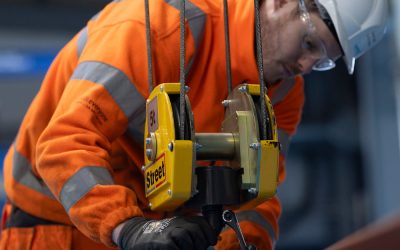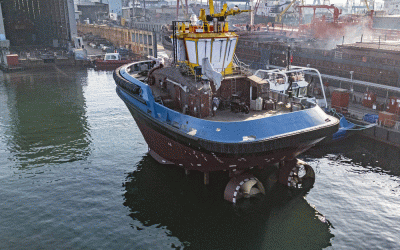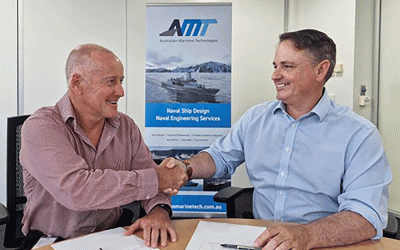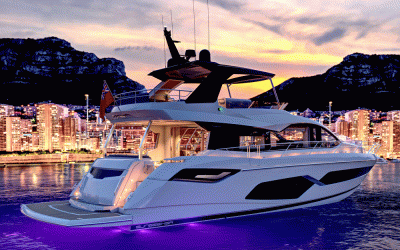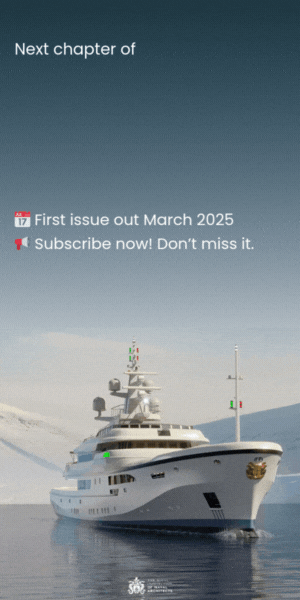It’s unlikely that many readers of the first issue of Ship & Boat International, published in 1947, could have envisaged a world of solar-powered ferries, unmanned tugs and offshore wind farms capable of powering tens of thousands of homes. Similarly, the abilities to conduct virtual reality walkthroughs of vessel plans, prior to construction, and to pay for yachts and vessel services using Bitcoin, might have seemed a tad far-fetched.
As for tugboats, bollard pulls in excess of 80tonnes, partly enabled by more powerful engines and the switch from open to nozzled propellers, may have been hard to imagine back then. And could readers have guessed that the mines littering Europe’s seabeds in the wake of WW2 would still be making life difficult for offshore site developers in 2022? There has been an enormous amount of industry change in the 75 years since, so let’s look at three of the key developments in our sector:
Green fuels
For a while, the idea of entirely removing petrol and diesel from boat operations seemed implausible. We don’t even have to travel back to 1947: this was a fairly common viewpoint as recently as the mid-2000s, when battery power was viewed as far too expensive and woefully insufficient to compete with diesel-fuelled vessels performance-wise.
Most of the changes in this regard have occurred in the past 10 years, with shrinking lithium-ion battery production costs and improved cell technology offering boatowners more bang for their buck, leading to greater uptake of all-electric and hybrid-electric powertrains. However, increased demand from the electric vehicle sector, and a surge in the price of nickel, mean that battery costs could shoot up in the next few years. It should also be considered that some repair yards have little to no experience of dealing with electric motors.
Fortunately, the industry is conducting similar investigations into methanol (which can be applied to diesel engines without incurring battery-related weight gains), hydrogen (whether supplied in dock or generated on board) and ammonia. The main drivers for this change are regional emissions restrictions and IMO mandates – but, whereas green fuels were once viewed as a costly, under-performing annoyance, they’re now fairly commonplace: it’s hard to think of an issue of Ship & Boat International in the past five years that hasn’t featured at least one vessel employing a low-emission powertrain.
Ferry safety
In 1947, the coastal passenger ferry Ramdas capsized off the island of Kashyacha Khadak, 10 miles from Mumbai – a tragedy in which 690 of her 713 passengers perished. It’s widely believed that the accident was caused by passengers rushing to the ferry’s port side immediately after a wave rocked the starboard side.
How has ferry safety changed in the decades since? While capsizals of the type described above have, regrettably, not been entirely eliminated, there has been an encouraging amount of progress. Initiatives hosted by the Worldwide Ferry Safety Association, as well as the LR Foundation-backed FerrySafe project and IMO’s recently introduced Model Regulations on Domestic Ferry Safety, have focused on ways to improve passenger ferry safety in countries across Asia, Africa and Latin America, and especially in accident blackspots such as the Philippines, Indonesia and Bangladesh.
The Philippines in particular has made vast improvements since the 2000s, with the authorities cracking down hard on irresponsible operators and lazy surveyors – moves that have seen the country greatly reduce its number of annual fatalities. Ultimately, though, this should be viewed as a good start, rather than a successful outcome: there is still much work to be done, here and elsewhere. Internationally based naval architects are greatly helping these efforts by providing input on vessel stability (factoring in passenger overcrowding, for example), with some firms even contributing their time and designs for free.
Unmanned vessels
Ironically, the concept of autonomous and unmanned vessels may not have been so surprising 75 years ago: after all, Nikola Tesla had showcased his radio-controlled boat to curious onlookers in Madison Square Garden, New York in 1898. Just six years after the publication of the first issue of Ship & Boat International, Dimitri Rebikoff unveiled ‘The Poodle’, credited as the first ROV, before the US Navy began to roll out ROVs in earnest in the 1960s.
We’ve gone from Tesla’s remote-controlled curio to a global offshore ROV and AUV market that’s predicted to reach US$7.2 billion by 2026, with an estimated 900 work-class ROVs currently in operation. Zero-crew vessels may still be some way off, but their development has gained pace in the past 10 years, serving as the ideal solution for the ‘three Ds’: work considered ‘dirty, dull and dangerous’. Uncrewed firefighting tugs, for example, could tackle shipboard and landside blazes in advance of human intervention, sparing personnel the risks of burns and toxic smoke. However, potential incidents don’t have to be dramatic: autonomous tech could reduce crew workloads and, consequently, their levels of stress and fatigue. There’s also the fact that smaller drones can access areas that would be unsafe for human divers, and impossible even for compact-sized vessels, to enter.
There are still a few boxes to be ticked regarding collision avoidance and operational liabilities – for example, if a remote-controlled workboat loses its connection with the shore and ploughs into a yacht, who would be held responsible: the remote coxswain, the shore command centre or the company who supplied the system? Expect more of these questions to crop up over the coming years.
